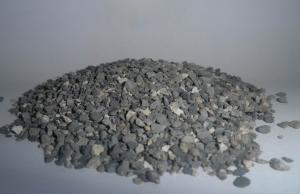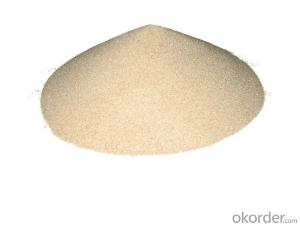Raw Materials for Refractory:Zircon Sands and Zircon Flour/Powder
- Loading Port:
- Tianjin
- Payment Terms:
- TT OR LC
- Min Order Qty:
- 25 m.t.
- Supply Capability:
- 3000 m.t./month
OKorder Service Pledge
OKorder Financial Service
You Might Also Like
Refractory Material/ Zircon Sands and Zircon Flour Good Quality
1.Structure of Zircon Sand and Zircon Powder
We are offer zircon sand With Below Mention Descriptions: ZrO2 65 - 67 %. We are offer zircon sand With Below Mention Descriptions: ZrO2 65 - 67 %. Zircon is a remarkable mineral, if only for its almost ubiquitous presence in the crust of Earth. It occurs in igneous rocks as primary crystallization products, in metamorphic rocks and in sedimentary rocks as detrital grains.
Further, the mineral due to hardness, durability and chemical inertness, zircon persists in sedimentary deposits and is a common constituent of most sands.
2.Main Features of Zircon Sand and Zircon Powder
1 Tiny, round, solid ball shape provides greater surface area for improved performance and dispersion in its application
2 High refractory rating, lower specific gravity rating, and higher service temperature produces greater yield
3 With lower bulk density, it offers better air permeability for better performance as a result of its overall physical characteristics
3.Main usage of Zircon Sand and Zircon Powder
Ceramic Industries – Wall Tiles , Floor Tiles , Roofing Tiles
Sanitary Ware Industries
Pottery Industries
Porcelain Glazes
Frit for Glaze and Enamels
Ceramic Colour Industries
Admixture for Glass , Opal Glass
Picture Tube Industries
Foundries , Investment Casting Industries
Special Refractories , Castable Refractories
Zircon Bricks , Zirconium Oxide Industries
Epoxy Resin , Special Paints Industries
4. Zircon Sand and Zircon Powder Images



5. Zircon Sand and Zircon Powder Specification
Specific gravity | 4.7 |
Bulk density | 170 – 180 lb/ft³ (2700 kg/m³) |
Hardness | 7.5 Mohs |
Angle of repose | 30° |
Melting point | 4000° F (2200° C) |
Thermal stability | no change to 3090° F (1700°C) |
Loss on ignition | 0.02 – 0.12% |
6.FAQ of Zircon Sand and Zircon Powder
1). Q: Are you a factory or trading company?
A: We are a factory.
2). Q: Where is your factory located? How can I visit there?
A: Our factory is located in China. You are warmly welcomed to visit us!
3). Q: How can I get some samples?
A: Please contact me for samples
- Q: what is the grading standards of external wall thermal insulation materials?
- 1. combustion performance of insulation material rates A EPS sea capacity module, rock wool, glass wool, foam glass, ceramic foam, foam cement, perlite obturator, etc. 2. combustion performance of insulation materials rates B1 Extruded polystyrene board (XPS) after special treatment / Special treatment of polyurethane (PU), phenolic aldehyde, gelatine powder polyphenyl granule3 combustion performance of insulation material rates B2 Molded polystyrene board (EPS), extruded polystyrene board (XPS), polyurethane (PU), polyethylene (PE), etc. See the 2009 edition construction technical measures 4.3.6 A graded insulation material is fire proof, but its thermal insulation performance is not so as organic XPS \ EPS. I feel the best insulation materials are Hairong EPS module. it is both insulating and fireproof and cheap. Insulation materials in the domestic market each has its shortcomings. Choose of materials should based on actualities in construction.
- Q: How to understand qualitative and qualitative refractory materials?
- Such as amorphous refractory castable, referred to as bulk loading, cast material, ramming material, refractory clay etc., utensils and other special products. Amorphous refractory material products, refractory heat insulating bricks and experimental and industrial crucible, spraying materials, such as burning bricks, electric melting brick, turn it into required shape and process heat treatment in where it is used.
- Q: How to divide the materials according to the National Fireproofing Material Standard?
- 2,generally, the external wall thermal insulation materials is divided in accordance with fire rating: 1, the class A combustion performance of insulation materials : inorganic fiber spray coating, glass wool, foam glass, foamed ceramics, rock wool, foam cement, hole-closed perlite ect.. 2) class B1 combustion performance of thermal insulation materials: Extruded polystyrene board (XPS) after special treatment / Special treatment of polyurethane (PU), phenolic aldehyde, gelatine powder polyphenyl granule, etc. 3) combustion performance of class B2 insulation material: molding polystyrene board(EPS), extruded polystyrene board (XPS), polyurethane (PU), polyethylene (PE), etc. I hope it will be helpful for you
- Q: which kind of fire?bulkhead is better?
- General business fire endurance of two products are 3 hours. Organic fire bulkhead's main ingredient is organic material, which can be used in anti-corrosion and fireproofing cable tray. Inorganic fire?bulkhead's main ingredient is inorganic material, which mianly play a role of fireproofing. It's main ingredient is inorganic material, so it can't be used in acidproof and alkali resistant projects. Of course, the price of same amount organic fire?bulkhead in general is more expensive than the inorganic fire?bulkhead.
- Q: What is the use of refractory?
- It is used as a protective layer inside the high-temperature, high-corrosion, high-washing, easy to be wore equipment and as an insulation layer outside equipment.
- Q: What are the insulation fireproofing materials?
- Asbestos is the most common. Asbestos containing zirconium and made of the mixture of zirconium aluminum and silicon through wire drawing is better. Of course, some are made directly from natural things which can withstand 1400 degrees for over 30 seconds while the internal temperature had no significant change, and withstand 1400 degrees for over five minutes while inside temperature increase does not exceed 5 degrees.
- Q: What substitutes are available for high-end refractories in addition to zircon sand?
- The composite sand powder can effectively replace zircon sand, with the same operation process, less operation time and environmental protection
- Q: The manufacturing technique of refractory material
- The major components of alkaline refractory material include magnesium oxide and calcium oxide. The commonly used alkaline refractory material is magnesia bricks. The magnesia bricks with 80%~85% magnesium oxide has good resistance to basic slag and slag and higher refractoriness than clay bricks and silica bricks. It is mainly used in open hearth, oxygen blowing of converter, electric furnace and smelting non-ferrous metal equipment and other high temperature equipment. Refractory materials applied on special occasions include high temperature oxide refractory materials such as alumina, lanthanum oxide, beryllium oxide, calcium oxide, zirconium oxide, etc., refractory compounds such as carbide, nitride, boride, silicide and sulfide, etc., and high temperature composite materials, including metal ceramics, high temperature inorganic coating and fiber reinforced ceramics, etc. Consult and find reference for efractory materials production equipment, go to http://hi.baidu.
- Q: can slag tailings be used to be the base materials of refractory materials ?
- perhaps not, because it has many pores.
- Q: Introduction to refractory material
- The best way to learn is on-site contact. If for produing purpose, it is better to ask teh leader of a plant. If for application, go to steel mill (cement plant, glassworks, etc.) to learn and look up information. Theory alone is of no help.
Send your message to us
Raw Materials for Refractory:Zircon Sands and Zircon Flour/Powder
- Loading Port:
- Tianjin
- Payment Terms:
- TT OR LC
- Min Order Qty:
- 25 m.t.
- Supply Capability:
- 3000 m.t./month
OKorder Service Pledge
OKorder Financial Service
Similar products
Hot products
Hot Searches
Related keywords





























